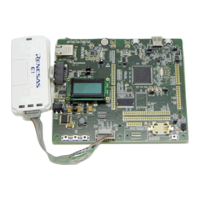R01UH0823EJ0100 Rev.1.00 Page 943 of 1823
Jul 31, 2019
RX23W Group 32. USB 2.0 Host/Function Module (USBc)
32.3.6 Control Transfers Using DCP
In the data stage of control transfers, data is transferred using the default control pipe (DCP).
The DCP buffer memory is a 64-byte single buffer and is a fixed area that is shared for both control reading and control
writing. The buffer memory can be accessed only through the CFIFO port.
32.3.6.1 Control Transfers When the Host Controller is Selected
(1) Setup Stage
Registers USBREQ, USBVAL, USBINDX, and USBLENG are the registers that are used to transmit a USB request for
setup transactions. Writing setup packet data to the registers and writing 1 to the DCPCTR.SUREQ bit transmits the
specified data for setup transactions. Upon completion of the transaction, the SUREQ bit is set to 0. The above USB
request registers should not be modified while SUREQ = 1.
After the attached state of the connected function device is detected, the first setup transaction for the device should be
issued by using the sequence described above with the DCPMAXP.DEVSEL[3:0] bits set to 0 and the
DEVADD0.USBSPD[1:0] bits set appropriately.
After the connected function device is shifted to the Address state, setup transactions should be issued by using the
sequence described above with the assigned USB address set in the DEVSEL[3:0] bits and the bits in the DEVADDn
register corresponding to the specified USB address set appropriately. For example, when PIPEMAXP.DEVSEL[3:0] =
0010b, make appropriate settings in the DEVADD2 register; when PIPEMAXP.DEVSEL[3:0] = 0101b, make
appropriate settings in the DEVADD5 register.
When the setup transaction data has been sent, an interrupt request is generated according to the response received from
the peripheral device (SIGN or SACK flag in the INTSTS1 register), by means of which the result of the setup
transactions can be confirmed.
A data packet of DATA0 (USB request) is transmitted as the data packet for a setup transaction regardless of the setting
of the DCPCTR.SQMON flag.
(2) Data Stage
Data is transferred using the DCP buffer memory.
The access direction of the DCP buffer memory should be specified using the CFIFOSEL.ISEL bit. The transfer
direction should be specified using the DCPCFG.DIR bit.
For the first data packet of the data stage, the data PID should be transferred as DATA1. Set data PID = DATA1 in the
DCPCTR.SQSET bit and the PID[1:0] bits = 01b (BUF). Completion of data transfer is detected using the BRDY or
BEMP interrupt.
For control write transfers, when the number of data bytes to be sent is an integer multiple of the maximum packet size,
software should control so as to send a zero-length packet at the end.
(3) Status Stage
Zero-length packet data is transferred in the direction opposite to that in the data stage. As in the data stage, data is
transferred using the DCP buffer memory. Transactions are done in the same manner as the data stage.
For the data packets of the status stage, the data PID should be set to DATA1 using the DCPCTR.SQSET bit.
For reception of a zero-length packet, the received data length should be confirmed using the CFIFOCTR.DTLN[8:0]
flags after a BRDY interrupt is generated, and the buffer memory should then be cleared using the CFIFOCTR.BCLR
bit.

